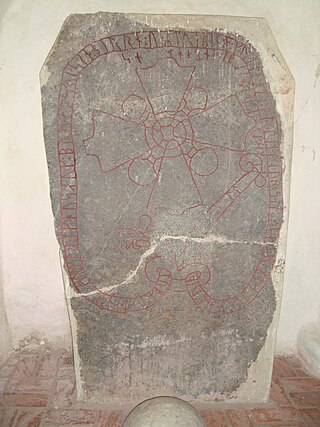The Funbo runestones constitute a group of four runestones originally from Funbo in the province of Uppland, Sweden, which were raised by members of the same family during the eleventh century.

Burestenen, or Nolbystenen, listed in Rundata as M 1, is a memorial runestone located in the Swedish province of Medelpad.

At Broby bro in Uppland, Sweden there are six runestones. U 139, U 140 and U 151 still stand by the road, but U 135, U 136 and U 137 have been moved a distance away from the road.

The Jarlabanke Runestones is the name of about 20 runestones written in Old Norse with the Younger Futhark rune script in the 11th century, in Uppland, Sweden.
The Hakon Jarl runestones are Swedish runestones from the time of Canute the Great.
The Ingvar runestones is the name of around 26 Varangian Runestones that were raised in commemoration of those who died in the Swedish Viking expedition to the Caspian Sea of Ingvar the Far-Travelled.

The Böksta runestone is a Viking Age memorial runestone that is located near the farm of Böksta in Balingsta, which is about four kilometers southwest of Ramstalund, Uppsala County, Sweden, in the historic province of Uppland. It is situated not far from Balingsta Church.

The Orkesta Runestones are a set of 11th-century runestones engraved in Old Norse with the Younger Futhark alphabet that are located at the church of Orkesta, northeast of Stockholm in Sweden.

The Hagby Runestones are four runestones that are raised on the courtyard of the farm Hagby in Uppland, Sweden. They are inscribed in Old Norse using the Younger Futhark and they date to the 11th century. Three of the runestones are raised in memory of Varangians who died somewhere in the East, probably in Kievan Rus'.
The Greece runestones are about 30 runestones containing information related to voyages made by Norsemen to the Byzantine Empire. They were made during the Viking Age until about 1100 and were engraved in the Old Norse language with Scandinavian runes. All the stones have been found in modern-day Sweden, the majority in Uppland and Södermanland. Most were inscribed in memory of members of the Varangian Guard who never returned home, but a few inscriptions mention men who returned with wealth, and a boulder in Ed was engraved on the orders of a former officer of the Guard.
The Italy runestones are three or four Varangian runestones from 11th-century Sweden that tell of warriors who died in Langbarðaland, the Old Norse name for south Italy. On these rune stones it is southern Italy that is referred to (Langobardia), but the Rundata project renders it rather anachronistically as Lombardy.
The England runestones are a group of about 30 runestones in Scandinavia which refer to Viking Age voyages to England. They constitute one of the largest groups of runestones that mention voyages to other countries, and they are comparable in number only to the approximately 30 Greece Runestones and the 26 Ingvar Runestones, of which the latter refer to a Viking expedition to the Caspian Sea region. They were engraved in Old Norse with the Younger Futhark.

The Varangian Runestones are runestones in Scandinavia that mention voyages to the East or the Eastern route, or to more specific eastern locations such as Garðaríki in Eastern Europe.
The Viking runestones are runestones that mention Scandinavians who participated in Viking expeditions. This article treats the runestone that refer to people who took part in voyages abroad, in western Europe, and stones that mention men who were Viking warriors and/or died while travelling in the West. However, it is likely that all of them do not mention men who took part in pillaging. The inscriptions were all engraved in Old Norse with the Younger Futhark. The runestones are unevenly distributed in Scandinavia: Denmark has 250 runestones, Norway has 50 while Iceland has none. Sweden has as many as between 1,700 and 2,500 depending on definition. The Swedish district of Uppland has the highest concentration with as many as 1,196 inscriptions in stone, whereas Södermanland is second with 391.
The Baltic area runestones are Viking runestones in memory of men who took part in peaceful or warlike expeditions across the Baltic Sea, where Finland and the Baltic states are presently located.

The Torsätra runestone, cataloged by Rundata as runic inscription U 614, is a Viking Age memorial runestone originally located in Torsätra, which is around 8 kilometers northeast of Bro, Stockholm County, Sweden, which is in the historic province of Uppland.

Sö 139 is a Viking Age runestone in granite inscribed in Old Norse with the Younger Futhark runic alphabet. It is located 3.5 m east-north-east of Sö 140 along the road between Lid and Aspa in Ludgo parish, in Nyköping Municipality, in Södermanland. Both stones are placed at the southern side of the road next to the brook at Korpbro. It is 1.48 m tall and 1.36 m wide. The style is tentatively categorized as Pr3. It is unusual because it was raised in memory of a woman.
The Södermanland Runic Inscription 49 is a Viking Age runestone engraved in Old Norse with the Younger Futhark runic alphabet. The style of the runestone is a categorized as Fp. It is located in Ene in Nyköping Municipality.

The Södermanland Runic Inscription 174 is a Viking Age runestone engraved in Old Norse with the Younger Futhark runic alphabet. It is located at Aspö Church in Strängnäs Municipality. The style of the runestone is a categorized as Pr1.

The Uppland Runic Inscription 948 is a Viking Age runestone engraved in Old Norse with the Younger Futhark runic alphabet. It is in reddish grey granite and is located at the Fålebro bridge, sunk into the ground, near Danmark Church in Uppsala Municipality. The style is Pr4.











